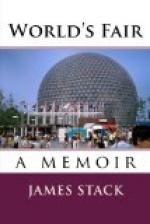In the nave there are several beautiful pieces of sculpture. One is a colossal group, representing St. Michael conquering Satan; another is a figure of the celebrated warrior, Godfrey of Bouillon, mounted on horseback; and a third, is an Amazon, who is just about to hurl her javelin at a ferocious tiger, who has fastened on the neck and shoulders of her frightened horse. Here is also a figure of Mazeppa on the wild horse, which is extremely well made, and, perhaps, reminds those of my little friends who have seen the play of “Mazeppa” at Astley’s Amphitheatre, of the scenes where poor Mazeppa was carried along on the terrible horse’s back, through brambles, thorns, and crashing boughs. But what have we here? A grim-looking growling bronze lion, from Bavaria, who glares at us as if he would be only too glad to eat us up if he were alive, and does not seem at all the kind of beast one would like to shake hands, or rather paws, with.
We have a charming representation of Reinecke Fox’s adventures, by means of stuffed animals, in the German portion of the Exhibition. The expression of the different animals is very funny, and makes us laugh to almost an inconvenient degree. The first group represents the fox, with his rosary in his hand, confessing his sins to the cock, who is listening very gravely, and reading him a sermon on his wickedness.
The next group shows the tom-cat, coming to summon Master Reinecke to court, to answer the accusations brought against him; the fox sets out, and on his way wounds a poor hare, whom he carries with him. But we cannot stay to notice all the groups now; only we must just glance at the fox lying on the sheep’s skin, after his repast, for here Master Reinecke’s expression shows him to be so well satisfied and comfortable that it is very droll.
In the Russian division we may observe a most magnificent pair of candlesticks of bronze, gilt, which look exceedingly sparkling and brilliant, and are the first objects that meet our eyes as we enter the department.
In the transept, at the opposite end to where the gates from Coalbrookdale are situated, are another beautiful specimen of ornamented gates for a park, in the style of the elegantly wrought iron work, made about a hundred and fifty years since, and which adorn the entrances to many of the old mansions of England. Some parts of these are tastefully gilt, and produce a remarkably pretty effect.
It would take us more than a month to see everything in the Crystal Palace, and those who wish to examine all the wonders, must pay several visits. But we have, I think, seen enough for the present, and will now leave the Exhibition, if you are satisfied. Perhaps, before I go, you would like me to describe the ceremony of the opening of our Palace of Wonders, by our good Queen? If so, I shall be very happy indeed to oblige you, by telling you all I saw on the first of May.
Early in the morning of that day,—soon after dawn,—thousands of people in London were wending their way towards Hyde Park; horses feet, and carriage-wheels clattered through the streets, and strange looking foreigners passed along among the crowd, all eager to see the procession.




